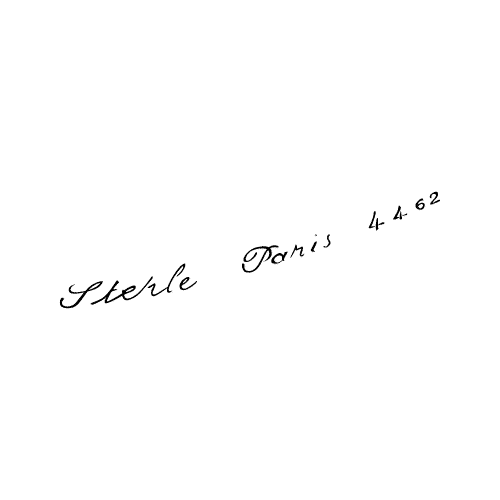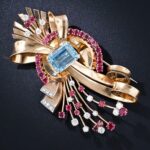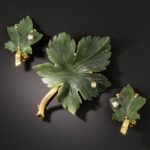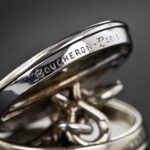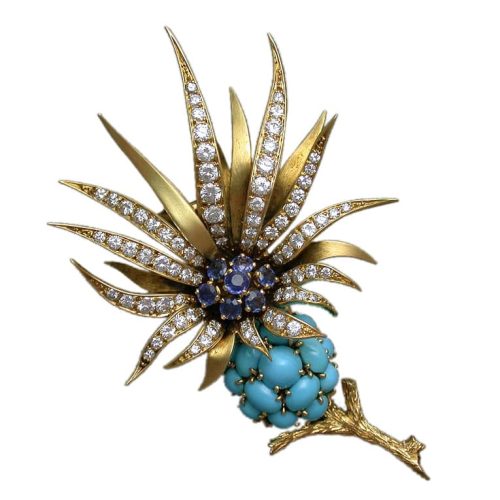
Sterlé was a French jeweller famous for his 1940s and 1950s designs. In 1934, Pierre Sterlé opened a workshop on Rue St-Anne. Some of Paris’s finest jewellers patronized him, including Boucheron, Chaumet, Ostertag. In 1939, having established a loyal following, Sterlé began to produce pieces exclusively for individuals. In 1945, he moved to 43 Avenue de l’Opera near the Place Vendôme. Like the jewellers at Boivin before him, and JAR after him, Sterlé thought of himself as a highly exclusive designer and refused to occupy a ground-level location where he would have to display his jewels in window cases, open to public view. His pieces were thus produced for, and seen by, a select few. If jewellery historians are to be believed, his clients and fellow jewellers considered him “a revolutionary figure” because of his work’s originality and his technical expertise.1 His favorite motifs included birds, wings, feathers, animals, and flowers. His designs were executed in a baroque, asymmetrical style and were typically embellished with a combination of precious and semi-precious gemstones. Some of them also featured “angel wire,” a mesh of sorts, which he created in 1957.2 During the 1960s, he sold his business to Chaumet. In the 1970s, he created “Oriental-style” jewellery for the firm.
Maker's Marks & Timeline
Sterlé
| Country | |
|---|---|
| City | Paris |
| Symbol | building, cartouche, frame, lozenge, oval, rhombus |
| Shape | cartouche, lozenge, oval, rhombus |
| Era | e.1934-1978 |
43 avenue de l’Opera
Specialties
Manufactured for
- Boucheron
- Chaumet
- Osterag
- Kirby
- Puiforcat
- Hair and hat ornaments.
- Gold & diamond studded leather goods.
1945
- Becoming very well-known
1950s
- Many famous clients
- King Farouk, Egypt.
- President El Khoury, Libya.
- President Vargus, Brazil.
- Wife of Maharaja of Baroda.
- Exiled Egyptian Queen, Switzerland.
Awards & designs
- Diamond Award from DeBeers.
- Becomes a member of the DeBeers Diamond Corporation.
- Invents Gold Thread
1960s
- Salvador Dali book cover for Livre de L’Apocalypse
- Financial and personal problems required him to sell of many possessions.
- The majority of his work was sold through Chaumet.
1969
- Opens his own shop.
1976
- Bankruptcy and stock liquidation (mostly to Chaumet).
- Sterlé becomes a Technical Consultant to Chaumet.
1978
- Sterlé dies.
Related Reading
Sources
- Raulet, Sylvie, Jewelry of the 1940’s & 1950’s. New York: Rizzoli, 1988.
- Traina, John. Extraordinary Jewels. New York: Double Day, 1994.
